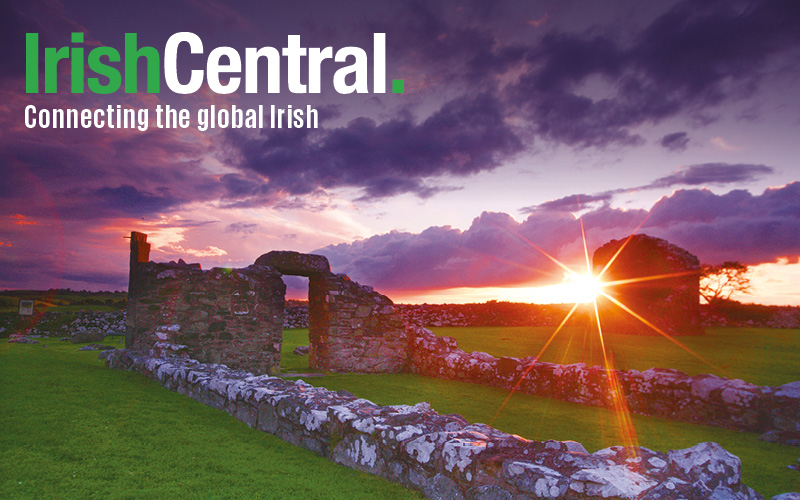To mark the opening of the exhibit The Fifth Province: County Societies in Irish America at the Irish Consulate in New York, co-curator Dr. Miriam Nyhan discussed the changing role of New York’s Irish county societies with CAHIR O’DOHERTY.
You can no longer make the kind of journey to America that your grandparents’ generation did. That involved American wakes, creaking ships or first plane rides, and it included the possibility it might be the last time you ever set eyes on your loved ones at home.
The unspeakable personal cost of those separations is the subject of a thousand Irish ballads, as are the challenges of what happened once they arrived. Those once in a lifetime voyages to the U.S. also involved finding your feet in a new nation, at a time when most Irish people might not have ventured two miles beyond their own townland in their whole lives.
Nowadays, of course, those kinds of journeys are no longer possible – but the memory of them, like the echoes of the Famine and the Civil War, live in all of us, and are a part of the Irish DNA.
No one in America has lived or recorded the challenges and opportunities faced by generations of the Irish quite like the various Irish county associations. For decades, and in many cases centuries, they have worked to recreate a sense of home, community and belonging through social, cultural and sporting events that have transformed and occasionally even saved the lives of the generations who joined them.
It’s not sentimentality to say that they were a blessing. The facts reveal how much they helped, publically and privately, to extend protective and benevolent assistance to thousands of hard working Irish people who made America their new home.
New York claims the largest cluster of these county societies, and it claims the oldest ones too, but the impulse to share the experience with others like themselves is one that has marked the Irish, no matter where they have settled in the world.
This month Dr. Miriam Nyhan, a faculty fellow and assistant professor at Glucksman Ireland House at New York University, has co-curated, with NYU’s Dr. Marion Casey, a groundbreaking new exhibition that celebrates the lifetime commitment that many Irish men and women have made to their own heritage (and its preservation) through their membership in county societies.
In her research Nyhan focused primarily on the 1950s Irish immigrants who settled in New York and London, but her work gave her an overview of the recent history of the societies too.
Unsurprisingly, since she’s made them her subject, Nyhan admits she’s a deep admirer of the work they do.
“I was interested in the lost record of the Irish, because there hasn’t been much research done on the Irish county societies here or the generation of immigrants who came here after World War II,” Nyhan told the Irish Voice. “At first I was interested in the London Irish, but pretty quickly I decided to make it comparative and chose New York.”
The question Nyhan asked herself was, as an intending immigrant to London or New York in the middle of last century, how would her experiences have been different?
“Irish county societies have been around in New York since the 1840s and they’ve had peaks and valleys. Closer to us in time, they enjoyed revivals during the 1940s though the early 1960s and that era probably was their heyday,” says Nyhan.
The point of them, and the reason for their success, was that they provided a familiar focus for the Irish arriving in New York. Predominantly, these were rural Irish people arriving in the teeming metropolis, and the county society’s made the place feel a little smaller, a little more like home.
There was an important benevolent aspect to their work too. When members got sick (in an era before any kind of social health care) they were provided for (death benefits in terms of burial expenses were taken care of too).
“For the majority of people it was a social and cultural space to come together and meet up and perhaps meet their future partners and in the process they made the big city a lot more manageable,” says Nyhan.
They were a homogenous group, those mid-century Irish immigrants, in terms of their backgrounds and attitudes. Most were rural, single, and had not completed second level education.
For the majority who joined, membership was casual and usually revolved around the annual dinner dance once a year, and marching with their county contingent on St. Patrick’s Day.
The GAA, the church, Communion breakfasts, dinner dances -- these were the signature events were thousands of single young Irish people met up often for the first time.
“You can only understand an immigrant if you understand where they came from and what their social context and outlook was,” says Nyhan. “County societies are very reflective of that history. That’s why I chose them.”
Every county society had its own chaplain, every meeting opened with a prayer, and Mass followed by breakfast was a common event.
“The societies reflected the outlook and traditions of the society that each generation came from. The presence of priests and religious orders were a natural part of that daily life,” Nyhan said.
But times change. The new Irish, the people who came in the 1980s, haven’t participated that much in county societies.
“County identity is not as important as it was 50 or 60 years ago. Back then a Limerick man could meet a Limerick woman. You’re talking about intermarriage when you go out of counties. The 1980’s crowd came from a different Ireland and were not as interested.”
It’s easy to be critical of county societies now that they’re often seen as parochial and old fashioned. But the world the older generation of Irish immigrants had come from was much smaller. It was a world where the boundaries of counties meant more than to the 1980s generation.
“There are different levels of education. The people who come in the 1980s have finished second level. They came on airplanes; they didn’t have an American wake. Why would you invest in these organizations of you don’t know if you’re here for the long haul?”
The Irish immigrants who came to the U.S. before the 1960s had historically low levels of return to Ireland. That’s changed now, and yet the county societies are still running strong -- some, such as the Cork and Kerry county societies for example, are thriving. What’s the secret of their success?
Mary Power, president of the Cork Association, one of the most successful in the greater New York area, has been presiding over a society that’s going from strength to strength. In the last two years it has hosted four major events, all of which were successful. Last year it hosted its own 125th anniversary banquet at Terrace on the Park in Queens, and the guests included Mayor Michael Bloomberg and Irish Foreign Minister Micheal Martin.
Pride in their Irish heritage is the driving force, Power says.
“In recent years the social aspects of society membership have been more to the fore, but the society still does charitable work,” Power tells the Irish Voice.
“Fundraisers have been held in recent years on behalf of Rachel Gorman, who was battling cancer. This year they society raised funds for young Saoirse Heffernan and her brother Liam, both of whom suffer from Batten Disease.”
By respecting the past and also staying current, the society maintains its relevance, Power says.
“The older members were born in Ireland and the majority of the younger members are Irish American,” says Power.
Incoming Cork Association president Tim Murphy is Irish American and was very aware of the importance of the society in his own family growing up. Those links are important and run deep.
“If you think about it, the first question one Irish person asks another is what county are you from. It helps them place the other person. That question may have meant more 50 years ago due to the impact of email and long distance phone calls now, but it still stands,” say Nyhan.
But your perceptions of home are shaped by the condition of the country the time you left. There’s a big generational divide between the post-World War II immigrants and the new Irish, Nyhan says.
This isn’t peculiar to the Irish. Perceptions can be frozen in the time that they left. That’s where you really see a generational divide.
“There was pretty much no Irish immigration between 1965 and 1985. That two decade period and in some people’s view disastrous to the county societies because it meant there was a big generation gap between the two waves,” Nyhan feels.
It’s all too easy to dismiss the views of each succeeding wave of the diaspora in a disparaging way, when the truth is a little more complex. The one thing you can say about the Irish county organizations is that they have demonstrated extraordinary staying power.
Unlike other ethnic associations in the U.S. they have lasted the test of time. They have not died out in the following generation. So far, though, the 1980s immigrants have not picked up on them, but that’s not to say they won’t as they mature.
“I don’t know whether we’ll see if the 80s crowd involve themselves. Whether they will or not will be key going forward. “We’re global Irish now. We’re less interested in being in New York and hanging out with Irish people. We’re not going to get as many people joining county societies,” says Nyhan.
There’s a perception they’re dominated by older Irish immigrants with a certain way of doing things, so the one thing that may save these societies is if immigration picks up from Ireland the way it looks like it might do.
“They were places were you went for a job, a place to live and possibly even a partner. If they fulfill a function going forward that’s when they’ll kick in again. I actually think they’re worth celebrating. No matter what way you look at it there’s still something good about having a group of people from your home county know you in this big city.”
The Fifth Province: County Societies in Irish America is now on exhibit at the Irish Consulate. For an appointment to view it call 212-319-2554.




Comments